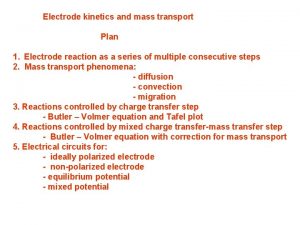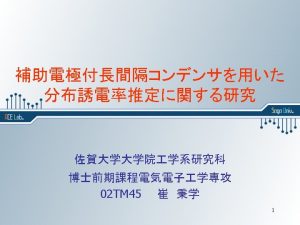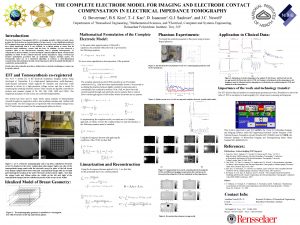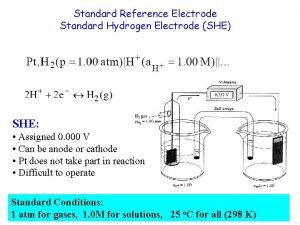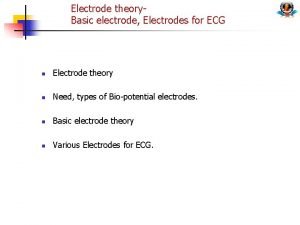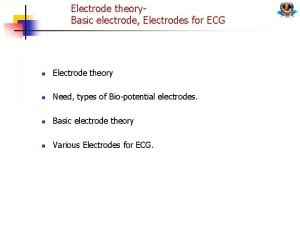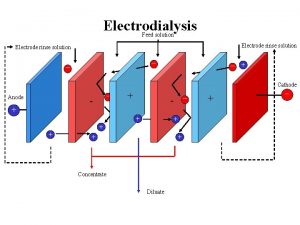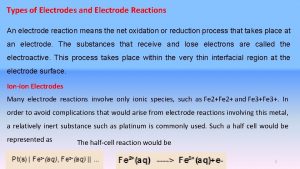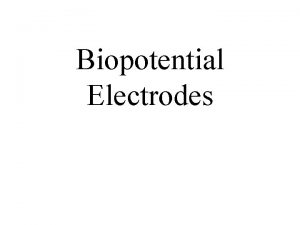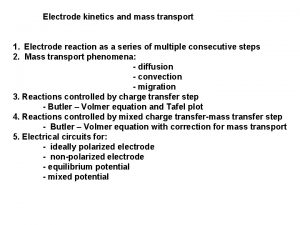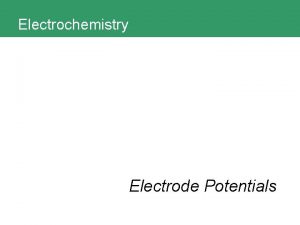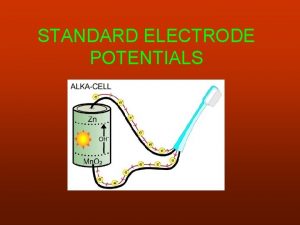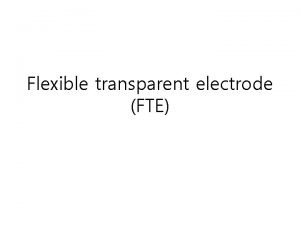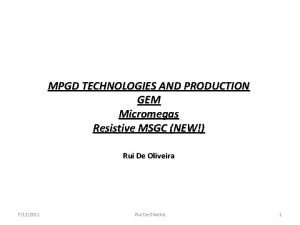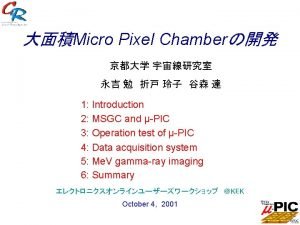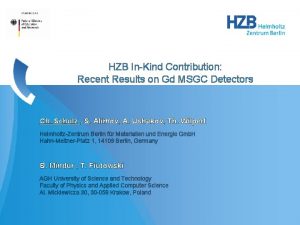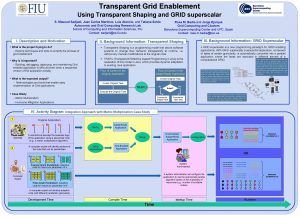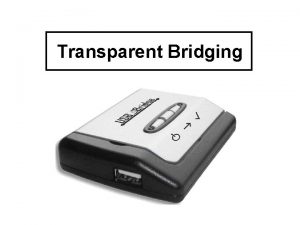The Transparent MSGC Study on transparent electrode ITOMSGC









































- Slides: 41

The Transparent MSGC Study on transparent electrode ITO-MSGC for Gas Proportional Scintillation Counter Takeshi Fujiwara, Hiroyuki Takahashi, Kaoru Fujita, Naoko Iyomoto Department of Nuclear Engineering and Management, The University of Tokyo, JAPAN MPGD’ 09 June 13 th 2009@Crete, Greece

Outline Introduction Multi-Grid MSGC (M-MSGC) Active scintillation method Fabrication of transparent M-MSGC (ITO) Test results in X-ray Summary

1. Introduction

J-PARC (Japan Proton Accelerator Research Complex) Overview MLF (Material and Life Facility) Facility for material analysis and life science 400 Me. V Lineac 3 Ge. V synchrotron MLF Mercury target

MLF spectrometers And more is being developed

MLF spectrometers Detectors are required to be… Neutron beam (Various wave length) Θ Detector • Capable in high intensity • 100 * 100 mm Size • < 1 mm spatial resolution Diffraction Target Mirror Diagrammatic sketch of Refelctrometer Neutron Reflectrometer A facility to analysis materials with reflection of neutrons

2. Multi-Grid MSGC (M-MSGC)

Diagrammatic sketch MSGC (Micro Strip Gas Counter) Electron Anode Avalanche • Micro-strip electrodes patterned on glass plate • <100µm between anode & cathode • Up to 1600 V between each strips • Electron is multiplied with avalanche and produces charge • Charge division readout method for 1 D position detection • 2 D position detection by layering 2 plates Cathode

MSGC (Micro Strip Gas Counter) Good Anode Bad • High count rate • Low cost • Could be used with high pressure gas Cathode • Charge up causes decrease of gas gain • Damage caused by sudden discharge • Bad in stability

Multi-grid-type MSGC (M-MSGC) • Charge up causes decrease of gas gain • Damage caused by sudden discharge • Bad in stability Separation of two strong electric fields Bad Anode Grid 1 Small surface charge Grid 2 . . . Cathode Vanode > Vgrid 1 > Vgrid 2 > Vcathode Low surface resistance Avoid charge-up and sudden discharge

A test plate consists of 4 grids + anode + cathode G 1 G 3 A G 2 G 4 C 400 mm 4 cm x 4 cm active area Anode width: 5 µm 4 grids(20, 25, 35, 42. 5µm) and 10 µm gaps

Pulse Height Spectrum for 6 ke. V X-rays 6 ke. V Experiment is done with 6 ke. V X-ray (@KEK Photon Factory) 0. 1 mmϕ beam, 400 cps/mm 2 Ar(30) + CH 4(70%)@1 atm Ar escape Obtained energy resolution was 14. 6% FWHM. (Gas gain =3000)

Neutron Image by Floating Pad Charge Division Method 6 mm 1 mm Spatial resolution 0. 6 mm FWHM

3. Active scintillation

Active scintillator method (proposed in MILAND) Incident neutron MSGC Tcharge signal Electron drift d Position Measurement at T=Gap/Vdrift Tprimary light Photo Multiplier Primary light signal enables to calculate the depth of interaction information, and reduce parallax error

Problems of conventional method Incident neutron MSGC Stop Unwanted diffraction Incident neutron Primary light Photo Multiplier Since neutrons have to go through the MSGC, unwanted diffractions and stops can be caused. Position Measurement at T=Gap/V drift

Problems of conventional method Incident neutron Primary light MSGC Electron drift Photo Multiplier In order to avoid unwanted diffraction or stop, MSGC should be under the conversion area. However, since ordinary MSGC’s are not transparent, primary light cannot get to PMT.

Problems of conventional method Incident neutron Primary light Electron drift MSGC Photo Multiplier But if the MSGC is transparent…,

Problems of conventional method Incident neutron Primary light MSGC Electron drift d Photo Multiplier But if the MSGC is transparent…, primary light signal enables to calculate the depth of interaction information, and reduce parallax error without worrying about the unwanted diffraction

4. ITO - The transparent MSGC

ITO MSGC ITO(Indium Tin Oxide) is known as a transparent conductive material used for LCD display. Optical transmission is 80 -90%. We fabricated a multi-grid-type MSGC using ITO. OA 10 glass substrate 170 nm thick ITO layer Use with Ar/CF 4 gas for efficient GSPC

This is ITO MSGC If you have super excellent eyes, may be you can see…

Picture of ITO MSGC ITO version of M-MSGC Electrode pattern is same as our conventional M-MSGC

Transmissivity of ITO

5. Test results with X-rays

Experimental Setup 55 Fe HV (4 ch out put) ORTEC 710 Ar(70%) + CH 4(30%)@1 atm 3 mm Cathode PMT Charge Signal Anode Hamamatsu R 5600 U Socket E 5780 Optical Signal Anode 3. 0 cm Tektronix DPO 4034 Oscilloscope F 8. 0 mm Chamber inside - 800 V PMT or ANODE ORTEC 570 HV(2 ch out put) ORTEC 456 Grid 1 Pocket MCA 8000 A PC Cathode Grid 2 PMT R 5600 U Active Sensitive area Area 2. 7 300 nm~ 650 nm cm

Test of operation as a proportional counter ANODE signal CATHODE signal Ar 70% + CH 4 30%

100 ns LIGHT CHARGE

ITO M-MSGC Obtained energy spectra Charge Light FWHM 25. 4% FWHM 27. 4%

Gas gain & PMT Spectra 3000 AMPLITUDE 2500 2000 Gas Gain 1500 PMT(Spectra) 1000 500 0 570 620 670 ANODE HV 720

5. 2. Position Scan with 6 ke. V X-ray beam

6 ke. V X-ray Test of position readout Experimental setup HV (4 ch out put) ORTEC 710 3 mm Cathode Hamamatsu R 2486 -02 PSPMT Anode Optical Signal Chamber inside - 1100 V HV(2 ch out put) ORTEC 456 Position Readout ORTEC 464 Ar(90%) + CF 4(10%)@1 atm Charge Signal Tektronix DPO 4034 Oscilloscope PMT or ANODE ORTEC 570 MPA PC PS PMT R-2486 Sensitive wave length 300 nm~ 650 nm

Position measurement Hamamatsu R 2486 -02 PSPMT Ar/CF 4 90: 10 X 1 Y 1 ITO-MSGC PS Module X 2 Y 2 ORTEC 464

Schematic of Hamamatsu PS-PMT R-2486 -2

5 mm Position scanned result obtained with PSPMT 6 ke. V collimated X-ray beam (scanned in 25 mm * 25 mm area) 5 mm Experiment is done with 6 ke. V X-ray (@KEK Photon Factory) Count 0. 1 mmϕ beam, 400 cps/mm 2 Hamamatsu PS-PMT R-2486 -2 + Ortec 464 Position Detection module Channel ≈2. 5 mm(FWHM)

900 850 800 5 mm Y Axis (Peak channel) Results of position scan by 5 mm Experiment is done with 6 ke. V Xray (@KEK Photon Factory) 750 0. 1 mmϕ beam, 400 cps/mm 2 700 Hamamatsu PS-PMT R-2486 -2 + Ortec 464 Position Detection module 650 600 550 500 450 500 550 600 650 700 750 800 X Axis (Peak channel) 850

Future work He 3 + CF 4 Tra nsm ITOMSGC Si. PM array issi v ity Optical mask (position modulation) ITO-MSGC Charge signal (Y) Normal PMT Light signal (X) Use both of charge/optical signal for position detection

Future work He 3 + CF 4 ITOMSGC Anger camera PMT

Summary ITO M-MSGC has been fabricated and tested with 6 ke. V X-rays. Position sensing by optical signal has been demonstrated. Active scintillation could be a solution for higher spatial resolution Optics for better light collection should be considered.

Thank you Takeshi Fujiwara fujiwara@n. t. u-tokyo. ac. jp

2 D Multi-Grid-Type MSGC by induced charge sensing Place FLOATING pads close to cathode Positive Ions stay on pads Pad charge can be read out through substrate A G Pad C Avalanche region Readout Strips Charge stay on pads
 Bổ thể
Bổ thể Biện pháp chống mỏi cơ
Biện pháp chống mỏi cơ Làm thế nào để 102-1=99
Làm thế nào để 102-1=99 Thiếu nhi thế giới liên hoan
Thiếu nhi thế giới liên hoan Vẽ hình chiếu vuông góc của vật thể sau
Vẽ hình chiếu vuông góc của vật thể sau Hát lên người ơi alleluia
Hát lên người ơi alleluia Một số thể thơ truyền thống
Một số thể thơ truyền thống Hệ hô hấp
Hệ hô hấp Công thức tính độ biến thiên đông lượng
Công thức tính độ biến thiên đông lượng Số nguyên tố là số gì
Số nguyên tố là số gì Tư thế ngồi viết
Tư thế ngồi viết đặc điểm cơ thể của người tối cổ
đặc điểm cơ thể của người tối cổ Tỉ lệ cơ thể trẻ em
Tỉ lệ cơ thể trẻ em Các châu lục và đại dương trên thế giới
Các châu lục và đại dương trên thế giới Phản ứng thế ankan
Phản ứng thế ankan ưu thế lai là gì
ưu thế lai là gì Thẻ vin
Thẻ vin Kể tên các môn thể thao
Kể tên các môn thể thao Cái miệng xinh xinh thế chỉ nói điều hay thôi
Cái miệng xinh xinh thế chỉ nói điều hay thôi Hát kết hợp bộ gõ cơ thể
Hát kết hợp bộ gõ cơ thể Từ ngữ thể hiện lòng nhân hậu
Từ ngữ thể hiện lòng nhân hậu Trời xanh đây là của chúng ta thể thơ
Trời xanh đây là của chúng ta thể thơ Tư thế ngồi viết
Tư thế ngồi viết V. c c
V. c c Gấu đi như thế nào
Gấu đi như thế nào Thơ thất ngôn tứ tuyệt đường luật
Thơ thất ngôn tứ tuyệt đường luật Hổ đẻ mỗi lứa mấy con
Hổ đẻ mỗi lứa mấy con Thế nào là hệ số cao nhất
Thế nào là hệ số cao nhất Diễn thế sinh thái là
Diễn thế sinh thái là đại từ thay thế
đại từ thay thế Slidetodoc
Slidetodoc Vẽ hình chiếu vuông góc của vật thể sau
Vẽ hình chiếu vuông góc của vật thể sau Thế nào là mạng điện lắp đặt kiểu nổi
Thế nào là mạng điện lắp đặt kiểu nổi Cách giải mật thư tọa độ
Cách giải mật thư tọa độ Lời thề hippocrates
Lời thề hippocrates Vẽ hình chiếu đứng bằng cạnh của vật thể
Vẽ hình chiếu đứng bằng cạnh của vật thể Chụp tư thế worms-breton
Chụp tư thế worms-breton Quá trình desamine hóa có thể tạo ra
Quá trình desamine hóa có thể tạo ra Sự nuôi và dạy con của hươu
Sự nuôi và dạy con của hươu Các châu lục và đại dương trên thế giới
Các châu lục và đại dương trên thế giới Dạng đột biến một nhiễm là
Dạng đột biến một nhiễm là điện thế nghỉ
điện thế nghỉ











































